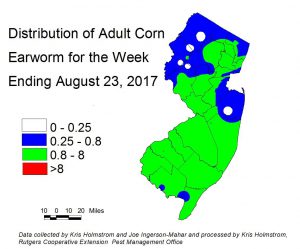Sweet Corn
European corn borer (ECB) catches have again declined to levels that do not permit a map image. This flight has been very sporadic. ECB feeding in NJ sweet corn plantings is very low, and has been largely obscured by fall armyworm (FAW) feeding. Check 5 plants each in 10 random locations for a 50 plant sample. Look for “shot-hole” injury, and consider treating when the number of infested (from ECB or FAW) plants in a 50 plant sample exceeds 12%. As infested plants proceed to the pre-tassel stage, live larvae and damage may be found in the emerging tassels. Once plants hit full tassel, ECB larvae will move downward on the stalk and re-enter the plant near the area where ears are forming. This can result in direct injury to the ear. Growers should consider an insecticide application at the full tassel stage to target ECB larvae as they migrate downward. This application can eliminate larvae that have escaped any earlier insecticide applications.
The highest nightly ECB catches for the previous week are as follows:
| Beckett 1 | Jobstown 1 | Oldwick 1 |
| Blairstown 1 | Milford 1 | Sergeantsville 1 |
| Clinton 1 | Old Bridge 1 | South Branch 1 |
Corn earworm (CEW) moth populations have increased dramatically in many parts of the state (see CEW map at left). The air mass over New Jersey late last week into the weekend was carrying a sizeable moth population. While this is not an extreme population, it has resulted in the tightening of silk spray schedules by one day in most areas. In this map, areas in green roughly correspond to a 3-4 day schedule, while blue areas are 4-5 days. White “holes” on the may represent traps that caught few or no CEW moths. These are outliers, and the broader color scheme in any particular region is more representative of the population. Be aware that synthetic pyrethroids have become less effective at managing ear infestations from this pest over the past several years. For this reason, it is advisable to include products in the IRAC group 28 (Coragen, Besiege) or IRAC group 5 (Radiant, Entrust (OMRI approved)).
The highest nightly CEW blacklight trap catches are as follows:
| Downer 5 | Folsom 4 | East Vineland 3 |
| Springdale 5 | Medford 4 | Beckett 2 |
| Cinnaminson 4 | Tabernacle 4 | Clinton 2 |
| Denville 4 | Centerton 3 | Jobstown 2 |
Southern NJ CEW pheromone trap catches have shifted to the northern end of the trap range this past week (see CEW pheromone map below at right), but remained generally steady. This network has a more conservative scale, and so the increase in the black lights has not translated to a difference in the pheromone map scheme. There are relatively few pheromone traps deployed compared to the number of blacklight traps in the state, resulting in much broader color bands on the pheromone map. Generally, the green portion of the map represents a 3-4 day schedule, while areas in red should adhere to a 3 day schedule.
At present, the highest nightly pheromone trap catches are as follows: 
| Jobstown 45 | Pole Tavern 17 |
| Beckett 27 | Pedricktown 13 |
| Green Creek 19 | East Vineland 12 |
| Berlin 18 | Elm 6 |
| Woodstown 18 |
Fall Armyworm
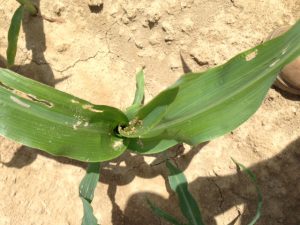 There has been little change in the fall armyworm (FAW) situation. This pest is present, but remains lower than expected for this time of year. Larval populations are being managed effectively with appropriate insecticides when the infestations are identified promptly. We should be alert for increased infestation in the near future. This pest favors smaller whorl stage plants, and will even infest seedling stage plants if
There has been little change in the fall armyworm (FAW) situation. This pest is present, but remains lower than expected for this time of year. Larval populations are being managed effectively with appropriate insecticides when the infestations are identified promptly. We should be alert for increased infestation in the near future. This pest favors smaller whorl stage plants, and will even infest seedling stage plants if the population is high. This pest is capable of serious injury to plants, and scouting should commence immediately on whorl corn throughout the southern half of the state. Look for plants with “window-pane” type feeding that leads from the outer leaf surface down into the whorl (see photo at left). As larvae grow, this damage will progress to obvious ragged holes, with lots of caterpillar droppings in the whorl. The larvae are tan and brown (see photo at right), with a conspicuous upside down “Y” on the head capsule. If FAW alone or in combination with ECB are found to infest 12% or more plants in the sample, consider an insecticide treatment. FAW do not respond well to synthetic pyrethroid insecticides. In general, IRAC Group 5 materials like Radiant or Entrust (OMRI approved) or IRAC Group 28 materials like Coragen (or those that contain Coragen as a component) work very well on FAW and other caterpillar pests.
the population is high. This pest is capable of serious injury to plants, and scouting should commence immediately on whorl corn throughout the southern half of the state. Look for plants with “window-pane” type feeding that leads from the outer leaf surface down into the whorl (see photo at left). As larvae grow, this damage will progress to obvious ragged holes, with lots of caterpillar droppings in the whorl. The larvae are tan and brown (see photo at right), with a conspicuous upside down “Y” on the head capsule. If FAW alone or in combination with ECB are found to infest 12% or more plants in the sample, consider an insecticide treatment. FAW do not respond well to synthetic pyrethroid insecticides. In general, IRAC Group 5 materials like Radiant or Entrust (OMRI approved) or IRAC Group 28 materials like Coragen (or those that contain Coragen as a component) work very well on FAW and other caterpillar pests.
Silking Spray Schedules*:
South – 3 days
Central – 3 days
North – 3-4 days
*These recommendations are based on regional catches. Adhere to tighter spray schedules if indicated by local trap catches.
Corn Leaf Rust
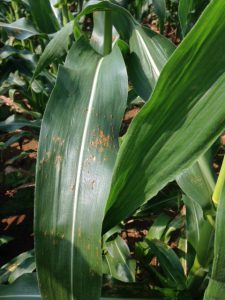 Rust is occurring with increasing frequency and severity in sweet corn plantings at this time (see photo at left). Our extremely wet summer is contributing to the difficult nature of this disease. Sweet corn should be scouted for this disease along with insect pests. If rust is found on whorl or younger stage sweet corn, there is a good chance it will negatively impact yield or ear quality. Check your seed source for information on the relative susceptibility of your corn varieties to this disease. If rust is occurring on plants prior to the tassel stage, fungicide applications may be warranted. See the Sweet Corn section of the Commercial Vegetable Recommendations for useful fungicides.
Rust is occurring with increasing frequency and severity in sweet corn plantings at this time (see photo at left). Our extremely wet summer is contributing to the difficult nature of this disease. Sweet corn should be scouted for this disease along with insect pests. If rust is found on whorl or younger stage sweet corn, there is a good chance it will negatively impact yield or ear quality. Check your seed source for information on the relative susceptibility of your corn varieties to this disease. If rust is occurring on plants prior to the tassel stage, fungicide applications may be warranted. See the Sweet Corn section of the Commercial Vegetable Recommendations for useful fungicides.
Pepper Weevil Update
Adult weevils have now been trapped in 3 additional fields in the Hammonton area (2 pepper fields and 1 eggplant field). Past reports from Florida and Georgia indicate that pepper weevil may reproduce in eggplant. This is the first instance of a pepper weevil being trapped in eggplant in NJ, although the have probably occurred in eggplant here before.
Additionally, 3 more weevils were trapped at or near 2 processing facilities in the Hammonton area. It is critical that fields be sprayed where even one weevil has been trapped so as to prevent the establishment of an infestation. Once a field is infested, eradication of the population will not be possible with currently registered insecticides.
Brown Marmorated Stink Bug
 Most black light trap catches of the brown marmorated stink bug (BMSB) remain in the southwestern edge of NJ (see BMSB map at left). While no reports of major stinkbug injury have come in from field scouts, BMSB and other stinkbugs can become a problem should the weather turn dry. Scouting for stinkbugs in these crops requires stealth, as the bugs will retreat into the canopy if they perceive a threat. While scouting for other insects and diseases, approach each sample site slowly. Before disturbing the foliage to search for ECB eggs, aphids, etc., observe the upper canopy for the presence of stinkbugs. Often, they will bask on the upper leaves. If adults, nymphs or egg masses are found in 2 or more sites in a pepper planting, consider treating preventively to limit feeding injury to fruit. There are several insecticide options listed in the 2016-17 Commercial Vegetable Production Recommendations.
Most black light trap catches of the brown marmorated stink bug (BMSB) remain in the southwestern edge of NJ (see BMSB map at left). While no reports of major stinkbug injury have come in from field scouts, BMSB and other stinkbugs can become a problem should the weather turn dry. Scouting for stinkbugs in these crops requires stealth, as the bugs will retreat into the canopy if they perceive a threat. While scouting for other insects and diseases, approach each sample site slowly. Before disturbing the foliage to search for ECB eggs, aphids, etc., observe the upper canopy for the presence of stinkbugs. Often, they will bask on the upper leaves. If adults, nymphs or egg masses are found in 2 or more sites in a pepper planting, consider treating preventively to limit feeding injury to fruit. There are several insecticide options listed in the 2016-17 Commercial Vegetable Production Recommendations.
Pumpkins and Winter Squash
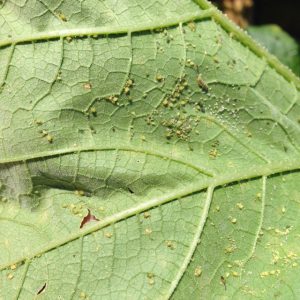 This is the time of year when melon aphid populations begin to appear in pumpkin and winter squash fields. These aphids have been found on increasing numbers of pumpkin fields over the past week, and can build to extremely high levels in fields (see photo at left), resulting in sticky droppings accumulating on the surface of maturing fruit.
This is the time of year when melon aphid populations begin to appear in pumpkin and winter squash fields. These aphids have been found on increasing numbers of pumpkin fields over the past week, and can build to extremely high levels in fields (see photo at left), resulting in sticky droppings accumulating on the surface of maturing fruit.
Cucurbit downy mildew (CDM) remains active on cucumber in NJ. As yet, no other cucurbit crops have been reported to be infected in NJ but cantaloupe infections are now being reported in New York and giant pumpkin and butternut squash infections have now been discovered in Sussex County, Delaware and Lancaster County PA. At this time, it is important for all cucurbit growers to check the below website at least weekly for updates on the movements of CDM in the eastern U.S. (http://cdm.ipmpipe.org/). With CDM now on giant pumpkin just to our west, it is advisable that pumpkin growers begin to add CDM specific materials to their fungicide rotations. ALL cucurbit crops should be scouted for the presence of CDM. CDM causes yellow lesions to develop on the upper leaf surface. Lesions are confined within veins initially, but coalesce quickly to kill the entire leaf when moist conditions prevail. Beneath these lesions (lower leaf surface), dark gray spores will be produced. If discovered, please report any incidence of CDM to your county agent as soon as possible.
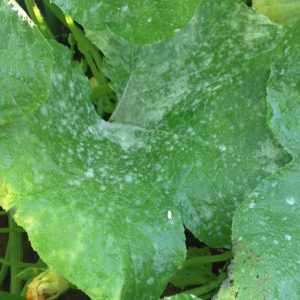 Powdery mildew (PM) infections are increasing normally on most pumpkin and winter squash fields. The appearance of PM is not related to weather, but rather the maturity and stress level of plants. This disease is not nearly as destructive as DM, but must be managed sufficiently to permit continued vine health. PM lesions first appear as circular clusters of conidia (spores) on the upper or lower surface of older leaves (see photo at left). PM typically appears as the earliest fruit are developing. The threshold for beginning the PM protectant fungicide program is the appearance of 2 leaves with lesions out of a sample of 100 older leaves. For a comprehensive list of useful fungicides and their use in rotation, see the Pumpkin and Winter Squash section of the 2016-17 Commercial Vegetable Recommendations Guide.
Powdery mildew (PM) infections are increasing normally on most pumpkin and winter squash fields. The appearance of PM is not related to weather, but rather the maturity and stress level of plants. This disease is not nearly as destructive as DM, but must be managed sufficiently to permit continued vine health. PM lesions first appear as circular clusters of conidia (spores) on the upper or lower surface of older leaves (see photo at left). PM typically appears as the earliest fruit are developing. The threshold for beginning the PM protectant fungicide program is the appearance of 2 leaves with lesions out of a sample of 100 older leaves. For a comprehensive list of useful fungicides and their use in rotation, see the Pumpkin and Winter Squash section of the 2016-17 Commercial Vegetable Recommendations Guide.
Tomatoes
As we get into the latter part of the growing season, caterpillar pest can become an increasing threat to tomatoes. Typically corn earworm (on tomatoes – tomato fruitworm) is the main threat. Moths lay eggs near upper flower clusters, and the larvae penetrate the shoulders of fruit near the top of the plants. CEW does not feed on foliage, and damage is often first discovered by harvesting crews. With CEW increasing now, it is wise to monitor fields weekl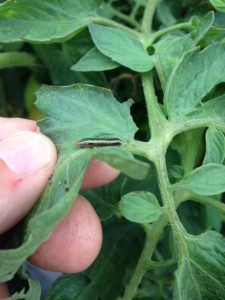 y for signs of increased fruit injury. While scouting 5 consecutive plants each in 10 field locations, note the presence of fresh fruit injury/live larvae. Should this occur in 2 or more sites within the field, consider an insecticide application to limit further injury. Products in the IRAC group 28 (Coragen, Exirel) or IRAC group 5 (Radiant, Entrust (OMRI approved)), are effective. Note that Coragen may also be used via drip irrigation. Another, less frequent pest that has appeared in a number of locations recently is the yellow-striped armyworm (YSAW). This brightly colored caterpillar (see photo at right) does feed on foliage prior to entering fruit, and it’s presence may be detected by foliar injury on outer canopy leaves. The same insecticide selections are useful for this and other armyworm pests.
y for signs of increased fruit injury. While scouting 5 consecutive plants each in 10 field locations, note the presence of fresh fruit injury/live larvae. Should this occur in 2 or more sites within the field, consider an insecticide application to limit further injury. Products in the IRAC group 28 (Coragen, Exirel) or IRAC group 5 (Radiant, Entrust (OMRI approved)), are effective. Note that Coragen may also be used via drip irrigation. Another, less frequent pest that has appeared in a number of locations recently is the yellow-striped armyworm (YSAW). This brightly colored caterpillar (see photo at right) does feed on foliage prior to entering fruit, and it’s presence may be detected by foliar injury on outer canopy leaves. The same insecticide selections are useful for this and other armyworm pests.
